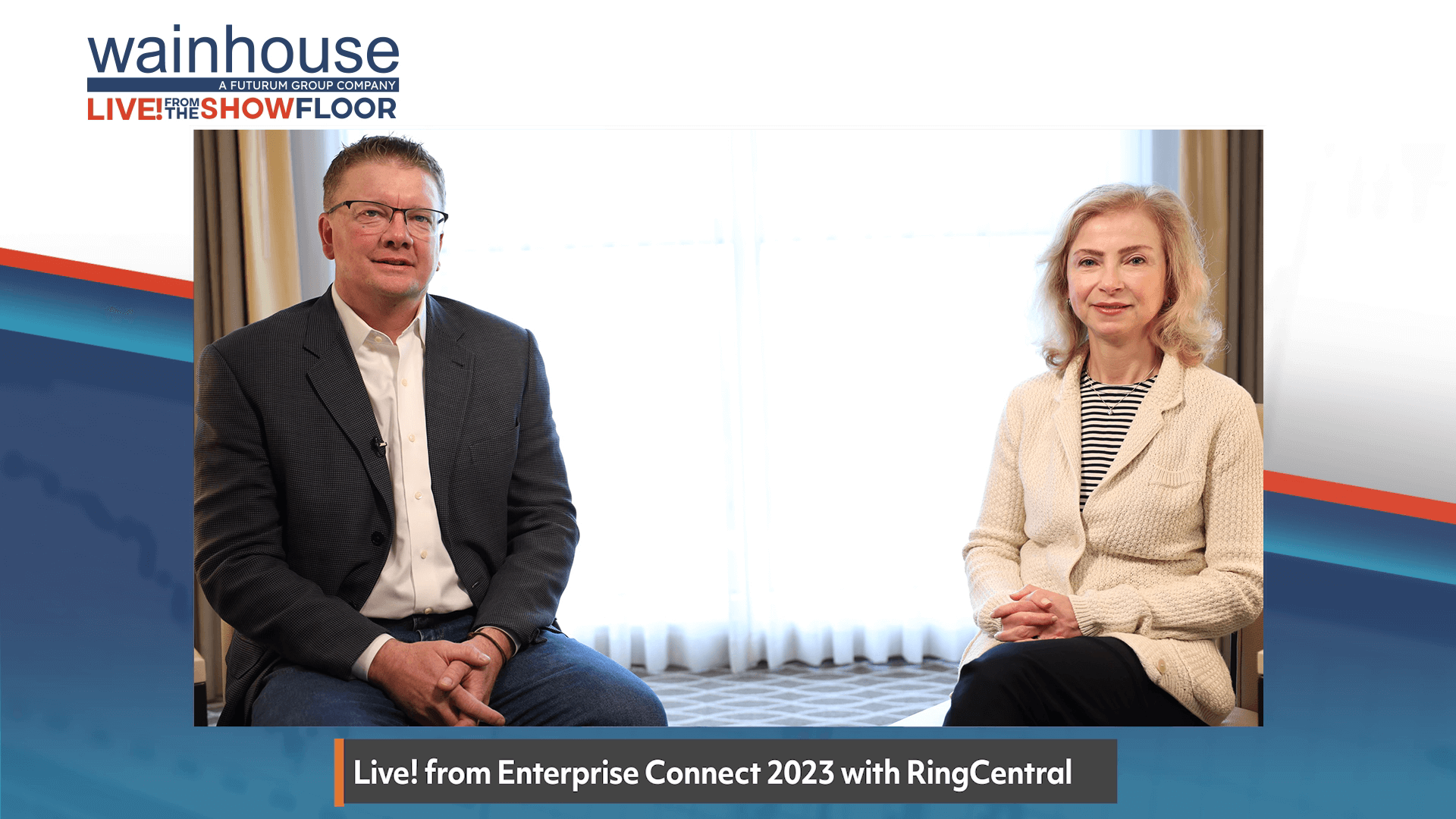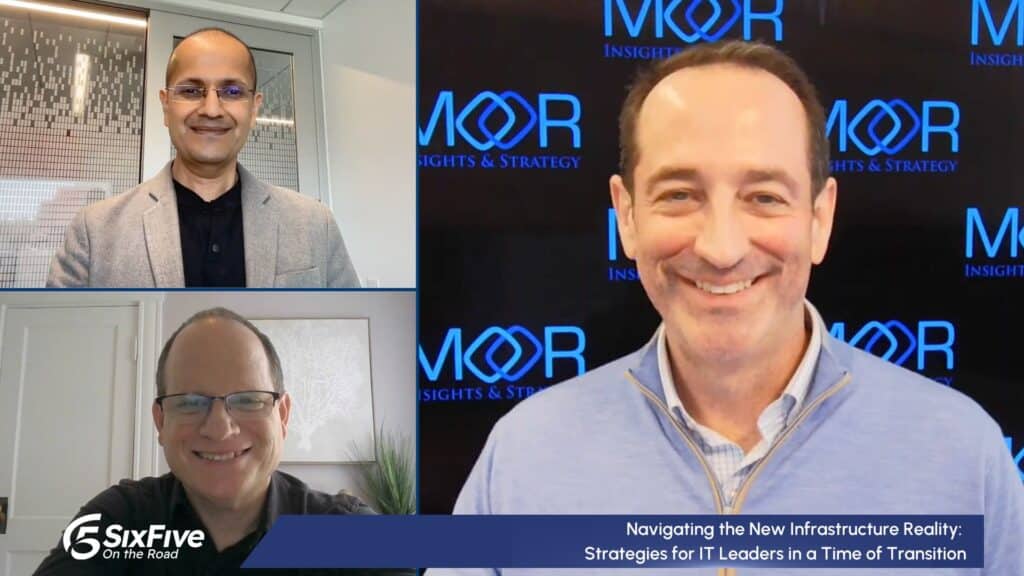In this episode of the Wainhouse Live! From the Show Floor video series, Wainhouse Senior Analyst Sean Spradling is joined by Kira Makagon, RingCentral’s Chief Innovation Officer at Enterprise Connect in Orlando. Their conversation revolved around:
- Recent advances in AI, hybrid work, solutions for Frontline Workers along with Contact Center products.
- As well as the value and shared obligation to mentor the next generation of workers in the technology sector.
Watch the episode here:
Disclaimer: The Wainhouse Research Webcast is for information and entertainment purposes only. Over the course of this webcast, we may talk about companies that are publicly traded and we may even reference that fact and their equity share price, but please do not take anything that we say as a recommendation about what you should do with your investment dollars. We are not investment advisors and we do not ask that you treat us as such.
Transcript:
Sean Spradling: Hello and welcome to Live from the show floor Enterprise Connect 2023. My name is Sean Spradling with Wainhouse Research. I’m the senior analyst for communications platforms and I’m joined by Kira Makagon, chief innovation officer with RingCentral. Kira, welcome.
Kira Makagon: Thank you. Glad to be here.
Sean Spradling: It’s really nice to see all of the announcements that are coming out of RingCentral. There’s been a release of the new webinar product. There’s the Push to Talk, there’s advancements in your CSAT platform. There’s a huge amount going on, but I know that there’s a theme underlying the whole thing that I’ve heard you talk about before. Tell us about intelligent connected experiences.
Kira Makagon: Right, so the umbrella for all our releases is intelligent connected experience. And what do we mean by that? What does intelligent mean? Well, the talk of day is AI and we’ve been at it for a while and we’ve injected AI into every aspect of communication. Last year we announced our Meeting Insights, which encompasses meeting summary’s highlights and transcription. These were the beginning of our journey and this year we announced RingSense. RingSense platform and RingSense for Sales, and that is about really injecting our AI platform, which is built on large language models, with generative AI that generates meeting summaries, that generates all aspects of enhancement for salespeople, this is RingSense for Sales. RingSense the platform is ability to essentially build on top of the RingSense platform with APIs that we expose, that we make it available to developers so that we can take QR customers and create value not only with the applications that we lease, but with the applications that they can build.
And then the intelligence behind RingSense really is quite unique. For example, RingSense for Sales, which is our first release, we are able to provide not only meeting summaries, but insights, action items to take into your favorite CRM system. Ability to enhance the productivity for salespeople in a way that hasn’t been done before and in a way that enables them to do better and their managers to observe them and to be able to look at, for example, automated scoring so that they can help those that need help the most, improve the conversations and therefore ultimately drive better customer value.
What do we mean by connected? Well, I talked a little bit about APIs for RingSense platform. Really we want to connect all aspects of communication because it’s very hard to live in different apps. You want to preserve context. To preserve context you need to enable to provide workflows between these apps, enable those workflows. Those workflows are enabled by APIs and those workflows are enabled by us being able to embed both in our platform different apps and be able to embed us in different applications. As, for example, we announced our video SDK that enables us to embed our video in, for example, an application for students so that they can see the teacher presenting, they can see the transcript and they can potentially also attach digital channels at the same time with their classmates and teachers. All of these are aspects of connected.
And then experiences. Everything I described is really about experiences. We want to make experiences more intuitive, more personalized, adaptive to the way that people work. Literally today we work on any device at any modality and that takes a lot of adjustment. So we want to make it as seamless as possible across all of those modalities. So for example, if you’re on your desk phone and you’re in a meeting and then you got to get up and go and get into a car and drive to your next meeting, you can do that with a switch of the button and switch the meeting to a mobile device and have the same continuous experience and no one really knows that you just moved from one place to another. And it’s what we call adaptive and that’s the basis of how we think of our experiences was really theoretical mobility being at the center of it because we’re always on the go today.
Sean Spradling: That’s amazing. Really end user-centric kind of view of the world. That’s perfect. Let me ask you, you mentioned AI and obviously AI is having a moment right now. It’s kind of a topic that we’re seeing across the spectrum from vendors. A lot of the solutions that are being released almost seem like AI for AI’s sake, maybe the marketing value of it. But you’ve taken a real use case-centric view of AI and application of AI. You’ve started with sales. Is there a view of what comes next, where you’re headed with longer term use cases?
Kira Makagon: Absolutely. So RingSense for Sales is the first release. Really we’re looking at the RingSense for Support, RingSense for other knowledge workers. You can envision that AI really, it’s an enablement and our AI is built on our own proprietary large language models, which really enables us to do the kinds of things that is very specific to potentially verticalization of that application. For example, not only for salespeople, but for salespeople that are, for example, in financial services industry so that when it listens to the conversation, it really understands the keywords that are really specific to financial services as opposed to keywords that are very specific to, for example, salespeople in a different field such as healthcare. We also take a lot of care to make sure that the privacy is observed, that it’s secure. We have years of building on a very reliable and trusted platform, and that’s really the foundation of how we think about AI because not only should AI enable, AI should also protect. And so we think that this is just the beginning of the journey. We’re at the very beginning of what will transform the way that we work and will really make us more productive and focus on what matters most.
Sean Spradling: models. I don’t have to worry about the chain of custody of my data as it moves through some of these open source platforms.
Kira Makagon: That’s right. That is not to say that we won’t be an open platform.
Sean Spradling: Well, sure.
Kira Makagon: Yes, and we’ve invested a lot of work into that.
Sean Spradling: You’ve also spoken in the past about hybrid work and we know that that’s a model that has come out and really gained popularity since the pandemic. We know that employees really, really like it, but organizations still tend to be struggling with exactly what it means. We at Wainhouse talk about companies having to earn the commute now. Workspaces need to be purpose driven and collaborative in nature and drive that sort of activity. How do your customers and how does RingCentral think about hybrid work and what’s on the horizon there?
Kira Makagon: Well, interesting enough, even though we’ve arrived at a hybrid model at a very accelerated pace during the pandemic, RingCentral when it was started, it was started with really three things in mind, easy to use, easy to buy, and easy to administer. And what we meant by that always, that people, IT professionals, they’re on the go, they’re always on the move. They’re kind of on the hybrid mode all the time and they walk around with the iPads or mobile phones. So we made sure that our applications work in any mode on any device from anywhere. So that’s the principles in which the company was founded.
Sean Spradling: Sure.
Kira Makagon: And so we think hybrid is just the way that people are going to work. This is about intelligent connected experiences from anywhere. And to be a little bit more specific, we really need to think of how to make it equitable for those people that are in the room and the people that are outside the room.
I talked a little about it yesterday on the panel. For example, when you are in the room when somebody speaks, you don’t know who that person is. When you’re on video and you’re in your square, there’s your name and it’s very clear. You raise your hand. It’s very clear. And all our tools enable that today. So how do you make it equitable for participants in the room? The irony of it is that’s actually something that we want to focus on in addition to remote workers. How do you make the camera angles right? How do you make whiteboards such that the whiteboard is visible to everybody who’s in the room or outside the room? All of those things are still work to do and something that we’re focused on. And for us, voice has always been the core aspect of communication, understanding voice intonations, understanding who speaks, understanding what language they speak in, being able to translate while they speak, being able to transcribe while they speak. All of those are parts of the hybrid communication that will make work not only easier and more productive and funner, so to speak, for all sorts of hybrid configurations, they’ll actually make it better for people in the room as well.
Sean Spradling: Absolutely. We talked a little bit earlier about frontline workers and we’ve done some research that estimates there’s about 2.1 billion frontline workers out there, which is a big expansion from the knowledge worker base that we’ve all been talking about for so many years, but they’re a widely variant set of job roles. It varies an incredible amount. How does RingCentral think about the frontline worker market and where does PTT and the early steps that you’ve taken into the frontline worker space take RingCentral over time?
Kira Makagon: So frontline workers, like you said, it’s a huge unaddressed market today really by communication collaboration providers. There are Push to Talk applications out there, but either they’re very basic and they usually almost require you to have another device, which is very inconvenient. So what we’ve done is we’ve built in Push to Talk into our application. There’s a button in our app, on our mobile app that you can push to talk, and it comes with ability to not only push to talk but be able to get, for example, on your back camera, you can capture what’s on the shelf or what’s on a construction site or maybe what’s in your medical office when you’re talking to a patient that need to share it potentially with a nurse next door. All of those aspects of incorporating also chat into that conversation is what essentially now empowers our Push to Talk to make it equitable for frontline workers to be able to have the same tools as back office people have and have gotten used to it. And also to connect frontline to back office. And really we envision that it will be adopted in various specific use cases by different verticals and empower those frontline workers to do what they need to do, again with more efficiency, ease and facilitated by technology that we provide.
Sean Spradling: the edge of your organization that you need to make sure that they’re informed as possible and then receiving data back from them in a really interactive way.
Kira Makagon: Exactly.
Sean Spradling: It’s nice to see that enabled. Well, we’ve spent a lot of time today talking about unified communications, but I know that there’s also the contact center side of your business. Talk to me a little bit about how those are converging, if they’ve converged, are they converging at all? How does RingCentral think about that?
Kira Makagon: So we really are the only company out there that combines the best in class in UCAS with the best in class with contact center. Our journey has been that of providing that fully integrated experience to our customers. And why does it matter that it’s fully integrated? It’s because you only now have one vendor to work with for all your telecom needs. You don’t need to have multiple agreements. You don’t need to worry about calling multiple lines of support. You really have one vendor that combines your employee experience and your customer experience into one integrated experience.
We talked about experiences and connected experiences and intelligent experiences. Well, there you go. That’s been the journey that we’ve been on. And our customers love it. They love the experience, they love the ability to easily go from one modality to another modality, meaning connect center to a phone experience for example, or what we call our MVP message, video phone, our application. And again, it’s seamless so that you have, again, your agents are connected to a knowledge of workers so that for example, if you have an agent group that needs help and there’s a question that needs to be escalated, that can be done seamlessly, taken back to a specialist who can then facilitate how to answer the question provided right back to the frontline agent.
Sean Spradling: Perfect. I’ve got one last question for you. I know that over the years, mentorship has been a theme for you, a really important theme for you. Tell me a little bit about how mentorship became important for you and what you think it offers the tech sector.
Kira Makagon: I grew up as the only woman in the room. That kind of dates me I guess. But technology has been a tough journey for women because there are few of us. And when there’s few of somebody, it’s a battle. It’s a battle because you’re different. It’s a battle because you have to be accepted. And I was really fortunate to have people along my journey that facilitated that almost in a way that needed… I didn’t notice. I traveled the journey and then when I arrived, I looked back, I said, “Wow, I’ve got help from all these people.” And it wasn’t that I even had to ask it was that they’ve noticed and they stretched their hand and they said, “Let me help you, let me guide you.” And not everybody’s that fortunate. And so giving back and helping younger women climb that ladder, and especially in technology, is something that I’ve been passionate about.
And it’s really just about opening to some extent their own biases and saying that everything’s possible. There are no boundaries. Just because you’re different gender or maybe you’re different ethnically, the differences don’t matter. It actually makes you stronger, it makes you better, it makes you stand out. And so I’ve been passionate about this topic. I’ve blogged on this topic, and I’ve worked with a number of younger women just helping them on their journey. And some of them have become hugely successful, hugely, way beyond what I would’ve imagined.
Sean Spradling: That’s great.
Kira Makagon: And what would they would’ve imagined for themselves. And then the other thing I recently did, which I really enjoyed, is not only giving back to women, but also giving back to the whole younger generation. I mentored a class at Stanford, a group of students that was working on a business plan, and that was a lot of fun. And that’s a way of giving back to schools that I’ve attended to or affiliated with, and really helping that younger generation feel stronger and travel that journey.
Sean Spradling: That is fantastic. Thank you very much. I know that there’s a lot going on for RingCentral right now. I really thank you for taking the time to share all of this with us.
Kira Makagon: Thank you.
Sean Spradling: Absolutely. My name is Sean Spradling, senior analyst for communications platforms at Wainhouse Research. Thank you again to Kira Makagon, chief innovation officer for RingCentral. Make sure to stop by the RingCentral booth or their website to find out about these innovations and more. And we’ll see you next time.
Author Information
Sean is a Senior Analyst strategically focused on cloud-based collaboration and its impact on worker productivity and human connection. Sean provides research on market sizing and forecasts, product and service evaluations, and end user/buyer insight.
Sean is a trusted advisor to and assists industry vendors and enterprises with workplace communications and collaboration strategies, market entry and product assessment, product portfolio analysis, and sales enablement services.
Prior to Wainhouse, now a part of The Futurum Group, Sean was the Chief Product Officer at PGI, owning the product strategy and roadmap for a full suite of B2B and B2B2C SaaS communications products including an enterprise grade phone system, audio meetings, video meetings, messaging, video webinars, high touch attended audio conferences and massively scaled video webcasts.
Sean holds a Bachelor of Science in International Business from University of Colorado, Boulder.





